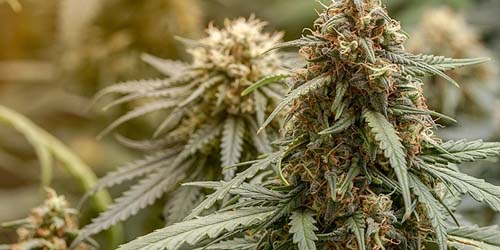
Awesome! You've decided to grow weed for the first time. Nice and all natural: in the garden or on the balcony. Growing weed outdoors has a completely different approach than growing it indoors. Just look at the light source. If you let the sun do the work, it saves on your electricity bill, but you also have to deal with the weather gods. Rain showers, bugs and storms are lurking. In short, there is a lot to be told about growing weed in the garden. In this short article you'll find all the basic rules for beginning growers, so you can get started properly prepared. Keep reading.
In this article
- Growing weed: What does a weed plant need?
- Choosing Weed seeds
- Germinating Weed seeds
- Weed Sowing and Seedlings
- The Growth Phase of the Weed plant
- LGBTQIA+ Weed – Gender determination
- The Flowering phase of the Weed plant
- Weather and Wind: Preventing problems
- When should I harvest the weed?
- Dry, cure and store weed
Growing weed: What does a weed plant need?
A weed plant has some basic needs: light, air, water and nutrients. When growing weed outdoors, the sun naturally provides the light. The need for light can vary with weed plants. For example, the need for daylight is greater during growth and the plant needs more sleep during flowering. The trick is to start germinating at the right time of year. For auto flowers: from the 15th of May (after Ice saints) until the beginning of August. For non-auto-flowers (so-called photoperiod weed plants): in the third week of May, preferably no later. This has to do with the available sunlight in the later life stages of the weed plants.
Luckily Mother Nature takes care of that for you when you grow outdoors. Weed plants extract two substances from the air: carbon dioxide through the leaves and oxygen through the roots. Although the first is automatic, the second is often a problem for weed growers. This problem is caused by the fact that the soil is too compact (mashed) or that the pot in which the cannabis plant is placed has no drainage. Drainage allows the excess water to drain away. Do you want to plant weed in the pot? Drill a number of holes in and around the bottom of a plastic pot. This will allow the excess water to drain away and provide the roots with oxygen.
A good basis is to prevent problems with growing weed. Take a look at this article for a more detailed version and you can only get off to a good start!
Watering the weed plant
It doesn't always rain when the weed plant needs it. If only it were such a treat. That's why you have to give weed plants extra water. Give the right amount of water that if you stick your thumb in the soil until the phalanx, the soil has to stick to your thumb. If it doesn't feel moist, then give more water.
Nurturing your weed plant
Weed plants need many different nutrients. Fortunately, rich potting soil or garden soil provides enough variety to meet the basic needs. But the need increases very quickly. That is why it is not only advisable to give supplementary nutrition; it is necessary. Nutrients are usually added to the water you give to your plants. Which nutrition and how much nutrition you should give, we will explain when it is needed in the course of this article. Do you want to know more about feeding right away? Read this detailed article.
pH-value
The water you give to your weed plants must have a favorable pH value. The acidity of the water and the medium is important because otherwise nutrients will not or not fully be absorbed. Make sure that the (nutrient) water has a pH value between 5.8 and 6.3. You can adjust the pH-value downwards with pH min from Plagron. Upward adjustment is not necessary in actual practice.
Choosing weed seeds
When you choose autoflower weed seeds, then it will be a little easier if you start growing weed outside. You don't have to take the seasons into account. Auto flowers will flower without having to make the nights longer. In other words, you can start as soon as there is no more night frost. And how long will it take to grow weed? From germination to harvest it takes a maximum of 15 weeks, often a few weeks shorter.
You can buy all kinds of weed seeds. Our tip: use the handy filters from our online seedshop. For beginners, our advice is to choose auto flower seeds, or at least choose weed seeds with beginner-level difficulty.
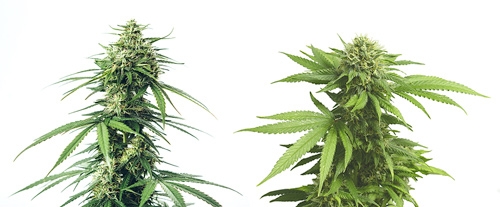
Sativa (left) vs. Indica weed (right). Which one is your favorite?
Germinating weed seeds
Germinating weed seeds is not difficult. Place the seeds between the cotton pads in our germination tray and wet the pads well. Within two to five days the root is long enough to plant them. There are many articles written about the germination of cannabis seeds. Also by us. Do you want all the tips listed? Check out these articles:
- Germinating Cannabis Seeds
- Sprout cannabis seeds like a pro!
- Germinating cannabis seeds with wads and Dutch-Headshop tray
- Help! My Weed Seeds Are Not Germinating
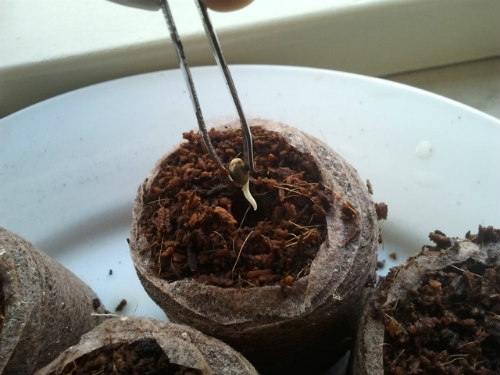
Only place germinated weed seeds in the soil, with the root downwards.
Weed sowing and seedlings
If you plant weed in a pot, you need to consider a pot capacity of at least 12 liters. The bigger the pot, the better for the plant. Give your plant room to grow by, for example, opting for a 40-litre tub. These are quite cheap, you can easily drill holes in them and they can be used again until the end of time. Weed needs loose soil to grow in. Choose standard potting soil for the tub or fertilized garden soil if you want to grow outdoors. Do not mash the soil! Choose a spot in the garden where the sun shines its light most of the day. Full sun.
Master tip for standard potting soil: make your soil richer in fungi and bacteria with one of our soil enhancers.
Place the germinated seed with the root down about an inch deep in the middle of the new soil. Cover lightly. Immediately give a little water and be careful not to wash away the soil.
Better yet: you can choose to grow your germinated seed first in a spongepot. In this phase you can put your plant on the windowsill, preferably in direct sunlight. If you don't give the seedling enough light, it will become unnecessarily long because the poor plant will start looking for light (stretching). By the way, keep the soil moist, but not soaking wet. We call such a young plant a seedling until it develops a few recognizable weed leaves.
Feeding: do not feed you plant is this phase.
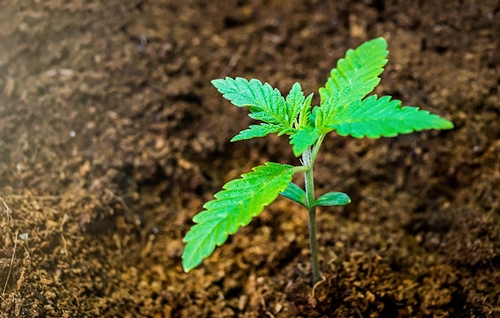
This seedling is allowed to go outside. She now has just enough leaves.
The Growth phase of the weed plant
After a few short weeks, a seedling passes into a growth or vegetative phase. You can recognize this phase by the emergence of full leaves (see photo). Two twigs grow on the stem of the weed plant. We call these nodes. If your plant has 2 or 3 nodes, your outdoor weed can go outside for the growth phase.
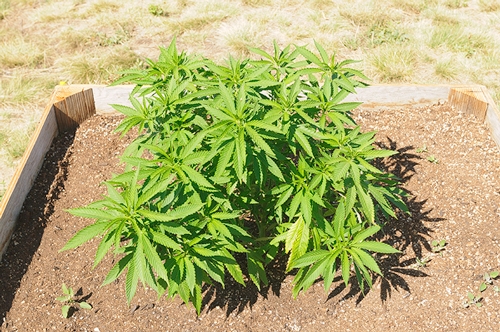
Weed plant during the growth phase - compact and small.
Feeding: Directly from the first week of the growth phase, you should give growth nutrients according to the instructions on the label. But make sure your plant is big enough. See the previous paragraph. Each growth nutrition has a different dosage. In addition you can choose a root stimulator. This can be given on top of the growth nutrient during growth.
LGBTQIA+ Weed – Gender determination
Weed plants have three genders. Males, females and hermaphrodites (both male and female). For the production of smokable weed flowers, we can only use the females. All our weed seeds are feminized. This means that the weed seeds are treated to maximize the chances of becoming females. However, this does not exclude the possibility that there may be a male in the mix! Feminized is not the same as guaranteed female. Before the flowering phase really starts, you can see in the leaf axils what gender your weed plant will become. This is a case of “a picture says more than a thousand words”:
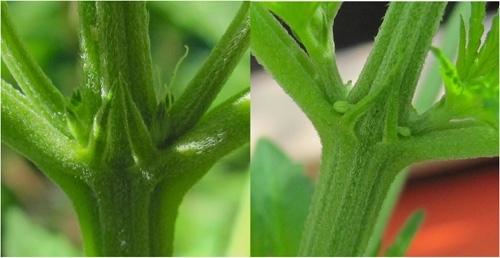
Left: female flowering hairs | Right: male bulbs
Do you see a male between your weed plants? Remove them before the flowering phase starts to prevent him from fertilizing your ladies with his pollen.
Stress (little water, diseases, hot summers and frost) can make your weed plant hermaphroditic with a small chance. A hermaphrodite can also develop later in flowering. That's why it's good to inspect your plant every now and then for small banana-shaped genitalia in the flowers. Because hermaphrodites also produce pollen, they can fertilize the female weed plants just like males. So remove the hermas as soon as possible.
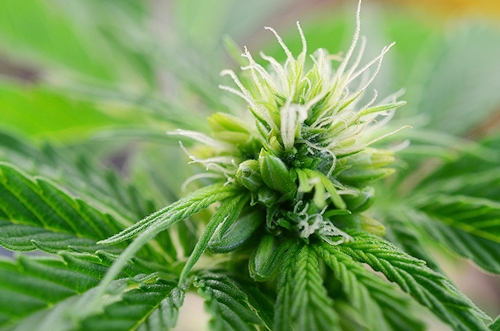
Hermaphrodite weed plant in a later flowering stage.
The flowering phase of de weed plant
The moment you are waiting for! In the end it's all about the flowers (buds) of the weed plant. That's where your yield grows. Auto flower weed plants will flower sooner and more fluently than photoperiod plants. Photoperiod plants start flowering around by the end of August; when it's dark at night for more than 10 hours. While the first flowers already appear, many weed plants continue to grow. Compared to Indicas, sativas also have a strong growth spurt. This creates more space between the nodes, especially in sativas. This stretching phase happens especially when the plant gets less light than desired. Especially in the period that the light becomes less intense. Stretching before the flowering phase is the reason why sativas often become longer and less compact than indica weed plants.
- With pure sativas you should expect a tree of 2 to 3 meters. In exceptional cases, they can even grow up to 4 meters high.
- Pure indicas often become bushy Christmas trees with a maximum height of 1.5 to 2 meters.
- Hybrids (cross sativa/indica) have an average maximum height, somewhere between the maximum height of a sativa and an indica.
- Auto flowers are usually only one meter high. Useful to know when you don't want them peeking over the fence in your garden.
Please note that sativas can double in height during the first few weeks of flowering. When grown indoors this stretching is much more visible than when grown outdoors due to the abrupt change of light schedule.
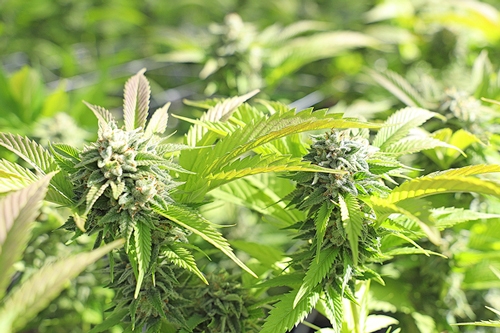
Excellent garden weed in bloom.
Feeding: Stop giving growth nutrient and switch to flowering nutrients. Furthermore, you can give root stimulator for up to 2 weeks. From the first week of flowering you can add a flowering stimulator to increase the yield. From the second week of flowering you can also give a so called PK-booster. This will give your weed extra flavour and possibly cannabinoids.
Rinsing: Stop feeding just before you harvest. We call it flushing cannabis. This improves the taste. What flushing is and how to proceed, you can read here.
Weather and Wind: Preventing Problems
Growing weed outdoors has some advantages. For example, you don't have to make a special grow room or grow box with equipment such as a fan. After all, garden weed gets enough wind. And that's necessary, because wind provides resilience in the stem of your weed plant. But summer storms can cause a lot of damage to your plant. Is there a storm coming? Then we advise you to secure your cannabis plant with (bamboo) sticks. By the way, these also help to support heavy buds, although this is usually not a problem when growing outdoors. A weed plant in full soil is difficult to move out of the wind, but we advise you to put the pots behind or in the shed until the storm has passed.
In case of heavy rainfall you can try to place an umbrella or cover above your plant. This will prevent water disturbance at the roots. Make sure that your construction cannot collapse to damage your weed plant. This is also not such a big deal for pot plants, as the excess water can be easily removed, as long as you have enough drainage holes. More about rain, storm and thunderstorms in this article.
With the arrival of autumn it generally becomes a lot more humid. Ideal conditions for mold. Threatening mold comes in the shape of top rot, mildew, rotten roots and false mildew. What you can do about mold, but also pests you can read in part 3 of the leaf problems blog series. Tip for beginners: choose a cannabis seed / strain with a short flowering period. This will prevent you from having to deal with damp and cold conditions late in the year.
When should I harvest the weed?
Weed is ready for harvest when the trichomes (resin glands) are predominantly milky white. In the picture below you see a top of a weed plant in the final stage of flowering. Numbers 1 to 4 show different balls of resin that are made by these resin glands. At number 1 it is too early to harvest. The resin is clearly transparent here. If most of the trichomes look like number 2, then it's time to harvest. It doesn't matter if a few balls start to turn amber like number 3. But don't wait until most of the trichomes have this colour. In simple words: your weed won't work as well then. If your weed starts to get brown like number 4, you are too late with harvesting. Of course you see all these colours at the same time on your weed plant - it's one picture after all. Again, the trick is to harvest when most of it is milky white (as number 2).
Trichomes are almost invisible to the naked eye. The best way to view the trichomes, is with a special weed microscope.
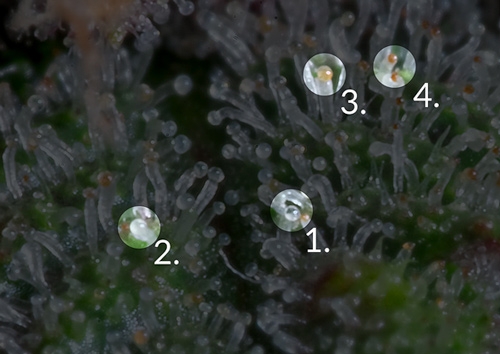
Trichomes in different stages.
What trichomes are and how to follow this process can be read in this extensive blog: How and when harvesting cannabis?? When it's time to harvest, first cut the bracts and leave the flowers on the branches, so you can hang them up and dry them easily.
Dry, Cure and Store Weed
Wet (or actually fresh) weed is not usable. As soon as you light it, it goes out again. It also contains a substance that makes your weed taste bitter and dirty. By drying your weed you kill two birds with one stone. Moisture and bitter taste go away! Drying takes 8 to 20 days depending on the method and your weed will lose 65 to 80% weight in moisture. After drying you put the weed tips in closed jars with a bag that keeps the moisture percentage exactly at the right level. This last step is called curing and makes sure your weed gets the right structure and taste you're used to from weed from the coffeeshop.
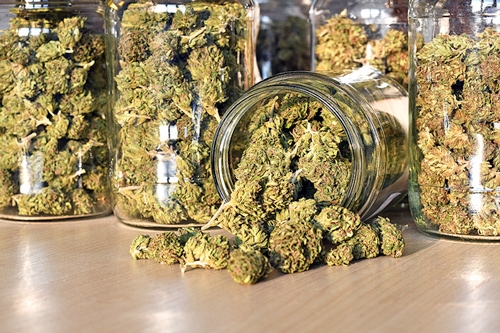
Reed all about drying weed in this article.. Read all about curing and storing your weed in this article.
As you can see, we already have a lot of blog articles if you want to dig deeper into the subject matter. The purpose of this article is to give you a broad perspective on the life stages of your weed plant and your yield, mainly focused on outdoor cultivation. In the next article we will tell you about the important things that come into play when growing weed indoors.